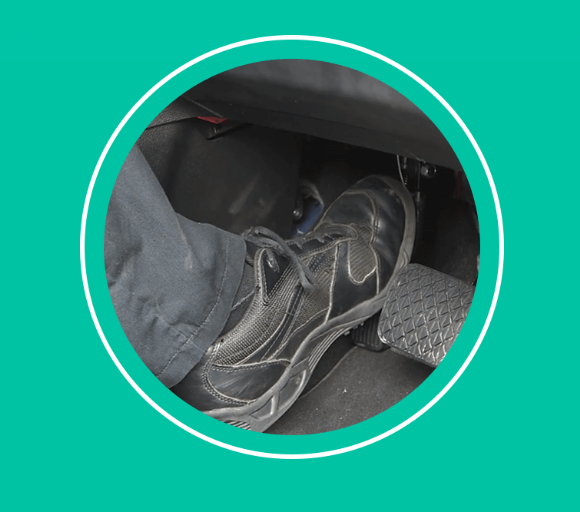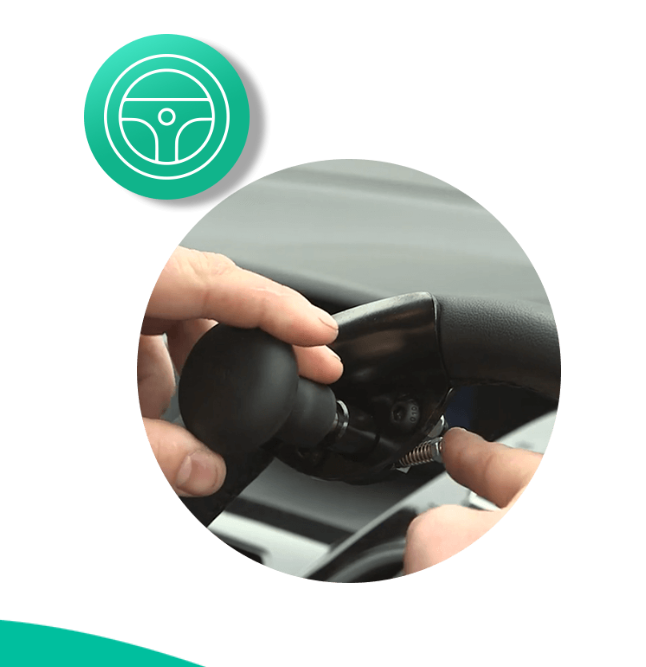Vehicle adaptations provide a little help for anyone who experiences difficulties in a standard car or van but still wants to retain their independence. Whether you have a car provided by Motability or your own car, disabled car conversions are available to assist with many aspects of driving, access and wheelchair stowage.
We investigate some of the professional adaptations and car conversions for disabled drivers that make every journey more manageable.

Driving Adaptations
Specialist installers can provide a range of disabled car conversions to assist driving - everything from simple steering, accelerator, brake and signalling attachments, to a custom-built system that replaces all controls.
Hand Control
How does it help? Accelerate and brake with your hand instead of your feet, for anyone with limited leg mobility or strength.
How does it work?
- A push/pull device is attached to the accelerator and brake.
- The handle is positioned next to the steering wheel.
- Pull to accelerate, push to brake.
- An additional switch operates the indicator.
Left Foot Accelerator
How does it help? Use your left foot for speed control instead of your right.
How does it work?
- A dual second pedal is fitted to the left of the brake pedal and linked to the original accelerator pedal.
- The right accelerator pedal either folds away or is protected by a pedal guard.
- Left foot is used to both accelerate and brake.
Electronic Accelerator
How does it help? Requires less effort than standard hand controls.
How does it work?
- A trigger accelerator is operated by the fingers - pull to accelerate and push to brake.
- An overing accelerator sits over the steering wheel - push to accelerate.
- An underring accelerator is attached under the steering wheel - pull to control the speed.
- A ghost ring accelerator is also attached under the steering wheel - side-to-side finger movements control the speed


Steering Aid
How does it help? Allows the vehicle to be steered with one hand and less effort than a standard steering wheel. It’s easier to grip, plus it gives you the freedom to operate other controls with your other hand.
How does it work?
- Use the grip to turn the wheel in the direction you need.
- Some can be removed and attached as needed.
- Options include ball or mushroom style, quick release mechanisms or tri-grip, pegs and straps for those with more challenging mobility issues.
Remote
Control Device
How does it help? Makes it easier to operate some of the car controls, such as indicators, wipers and headlights.
How does it work?
- Button operated device that attaches to the steering wheel.
- Press relevant button to activate car feature.
- Can also include steering aid so that steering and operation of basic car functions can be done with one hand.
Access Adaptations
If you’re a wheelchair user, getting into and out of a car or van can sometimes be difficult. The right adaptation or car conversions for disabled drivers and passengers could help you to access your vehicle more easily.
Transfer Plate
How does it help? Provides a smooth surface between the wheelchair and the car seat to help with the transfer.
How does it work?
- The transfer plate is fitted to the side of the car seat.
- Once in the car, the plate can then be moved safely out of the way.
- On arrival at the destination, the plate is moved out again
- Electric and manual versions are available.
Person Hoist
How does it help? Physically lifts you into the car as an alternative to getting a fully converted wheelchair-accessible vehicle.
How does it work?
- A permanent mount is fitted into the car and three easily assembled parts clip together to form the frame.
- A specially designed sling is put into position with very little movement required from the user.
- Four heavy duty hooks on the sling are slipped onto the hoist and the hoist is raised electronically.
- Once seated in the car, the frame sections of the hoist can be removed and stowed in the boot
- The sling remains in place, making it easy to reverse the process at the end of the journey.
- You’ll need to check with an adaptation installer that your car is suitable for this type of hoist.


Swivel Seat
How does it help? Makes it easier to transfer from the car to your wheelchair.
How does it work?
- Vehicle swivel seats can be manual or motorised, and fitted to either the driver or passenger side.
- If using a manual version, you or your partner must be able to manoeuvre your seat into the correct travelling position.
- Alternatively, a wheelchair swivel seat allows a specially adapted seat to slide out onto a manual or powered wheelchair base which may need a hoist or platform lift to load or unload from the vehicle.
- Make sure there’s enough space for your legs to be moved into the travelling position.
- Speak to an adaptation installer to find out which swivel seats might be suitable for your car.
Stowage Adaptations
Make light work of lifting your wheelchair or scooter into your vehicle with disabled car conversions that include a stowage system, such as a boot hoist or rooftop unit.
Car Boot Hoist
How does it help? Assists with getting Your wheelchair/scooter in and out of the boot.
How does it work?
- The hoist is fitted to your boot by a professional installer.
- Dismantle your wheelchair/scooter as much as possible so that it will fit into your boot.
- Attach the hoist to your wheelchair/scooter.
- The hoist will lift your scooter off the ground until it’s level with your boot.
- Guide the scooter into the boot of your car and secure it using the tie downs.
- Reverse the process to get the wheelchair/scooter out of the boot.
- Detach the hoist from your wheelchair/scooter.
- You’ll need to check with an adaptation installer which hoist is suitable for your vehicle.
Rooftop
Stowage Unit
How does it help? A simple way to store your folding wheelchair on the top of your vehicle without any physical lifting.
How does it work?
- The rooftop stowage unit looks like an ordinary roof box and is mounted by a professional installer on your vehicle’s roof.
- Transfer from your wheelchair into the car or van.
- Use the handheld switch to open the unit and lower the lifting mechanism.
- Attach the wheelchair to the lifting mechanism.
- Press switch to lift wheelchair into stowage unit.
- On arrival at destination, reverse process.
- The rooftop stowage unit can usually be used on either the passenger or the driver side.
With suitable adaptations and car conversions for disabled drivers and passengers available on most vehicles, there’s plenty of reasons why you could be enjoying vehicle travel in an easier and more comfortable style.
For more details and help choosing the right adaptation for you, get in touch with your local Swansway Group Motability adviser.